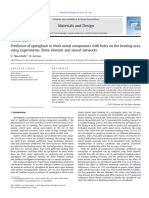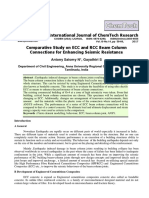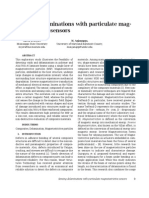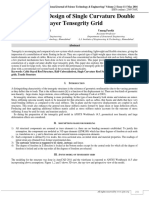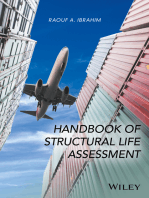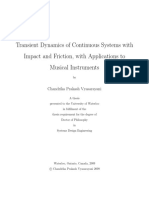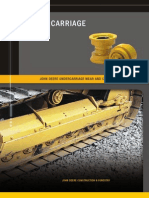Study On Improvement of Damping in Jointed Cantilever Beams Using FEM
Study On Improvement of Damping in Jointed Cantilever Beams Using FEM
Uploaded by
Hamed MasterCopyright:
Available Formats
Study On Improvement of Damping in Jointed Cantilever Beams Using FEM
Study On Improvement of Damping in Jointed Cantilever Beams Using FEM
Uploaded by
Hamed MasterOriginal Title
Copyright
Available Formats
Share this document
Did you find this document useful?
Is this content inappropriate?
Copyright:
Available Formats
Study On Improvement of Damping in Jointed Cantilever Beams Using FEM
Study On Improvement of Damping in Jointed Cantilever Beams Using FEM
Uploaded by
Hamed MasterCopyright:
Available Formats
ISSN: 2319-8753
International Journal of Innovative Research in Science,
Engineering and Technology
(An ISO 3297: 2007 Certified Organization)
Vol. 3, Issue 6, June 2014
Study on Improvement of Damping in Jointed
Cantilever Beams Using FEM
R.C. Mohanty 1, Rajendra Kumar Mohanty 2, B.K. Nanda 3
1
Associate Professor, Department of Mechanical Engineering, Centurion University of Technology and Management,
Jatni-752050, Orissa, India
2
Research Scholar, Department of Mechanical Engineering, Centurion University of Technology and Management,
Jatni-752050, Orissa, India
3
Professor and Vice Chancellor, Veer Surendra Sai University of Technolgy, Burla-768018, Orissa, India
ABSTRACT: Damping in built-up structures is produced by the energy dissipation due to micro-slip along the
frictional interfaces. The analysis of the problem has been carried out using Finite Element Method (FEM). A finite
element model of the linear elastic system has been formulated using the Euler-Bernoulli beam theory to investigate the
damping phenomena in riveted connections. The discrete element system having two degrees of freedom per node
representing v and v x has been used for the analysis. The solution considers one-dimensional beam elements with
each one consisting of two nodes having two degrees of freedom, i.e. transverse displacement and rotation at each node.
The generalized stiffness and mass matrices for this element has been derived. Extensive experiments have been
conducted for the validation of the analysis. From this study, it is established that the damping capacity increases and
the natural frequency decreases due to the joint effects.
KEYWORDS: Shape function; stiffness matrix; interface pressure; micro-slip; damping capacity.
I. INTRODUCTION
Usually, the fabricated or built-up structures possess low material damping which can be adequately compensated by
incorporating suitable joints to construct the same. The contribution of damping due to joints to such structures depends
largely upon its behavior under dynamic conditions. Gropper [1] and Menq et al. [2] have shown that joints usually
exhibit two types of motions; micro-slip and macro-slip. The micro-slip usually occurs with small relative displacement
between the contacting members resulting in energy losses at the joints causing the damping of the structures. Beards
[3] has performed a series of experiments on the damping of the joints to control the vibration of a structure and
established that the damping in joints is much larger compared to the material damping and there exists an optimum
clamping force at which the energy dissipation is maximum. Shin et al. [4] have shown that the damping effect is
negligible when the joint is very tight. They further established that the natural frequency decreases and the damping
capacity increases with the loosening of the joint. Damisa et al. [5] have studied the effect of non-uniform interface
pressure distribution on the mechanism of slip damping for layered beams. However, their analysis is limited to static
load and linear pressure profile. Further, Olunloyo et al. [6] have also studied the damping mechanism with polynomial
and hyperbolic forms of interfacial pressure distribution.
Many boundary and initial value structural engineering problems are solved with the application of finite
element method (FEM). However, its application in damping analysis is relatively recent. Gaul and Lenz [7] have
worked in details on the finite element models of different slip mechanisms to study the dynamic response of
assembled structures incorporating both the micro- and macro-slip of several bolted/riveted joints. Chen and Deng [8]
have proposed a finite element method for understanding and characterizing the non-linear damping behavior of
structural joints. Hartwigsen et al. [9] have found out the contact area of bolted joint interfaces using FEM analysis and
they further conducted the experiments to verify the same. Sainsbury and Zhang [10] have used finite element analysis
through Galerkin element method (GEM) to study the dynamic analysis of damped sandwich beam structures. . Lee et
Copyright to IJIRSET www.ijirset.com 13030
ISSN: 2319-8753
International Journal of Innovative Research in Science,
Engineering and Technology
(An ISO 3297: 2007 Certified Organization)
Vol. 3, Issue 6, June 2014
al. [11] used the finite element model of a jointed beam to obtain the natural frequencies and mode shapes. Oldfield et
al. [12] have investigated the damping of an assembled structure using the dynamic frictional contact analysis under
harmonic loading by the finite element analysis.
Although, a lot of analytical, computational and experimental works have been carried out by several researchers in the
recent past on the damping of bolted structures, but no substantial work has been reported till date on the damping
capacity of riveted structures. Hence, an attempt has been made in the present investigation to analyze the damping
mechanism in assembled structures using the finite element models and to study the effect of various parameters on the
damping of layered and jointed cantilever beams having thickness ratio of 1.5. Further, the finite element model
analysis has been validated with experiments.
The finite element method is widely employed to solve many boundary and initial value engineering problems and its
application in damping analysis has been studied by many researchers [1-4]. Among the work done by many authors,
Nanda and Behera [5] have studied damping in layered and jointed bolted structures using the classical energy
approach. However, a very little amount of work has been reported till date on the damping characteristics of riveted
joints. Further, the bolted and riveted joints exhibit different damping behavior because of varying interface pressure
distribution characteristics and zone of influence under similar dynamic conditions. A finite element approach based on
the energy dissipation mechanism has been presented to investigate the damping in jointed and riveted structures.
II. FINITE ELEMENT FORMULATION
A standard discretized beam element has been modeled using two nodes with each one consisting of two degrees of
freedom (translation and rotation) as shown in Fig. 1. Assuming that each layer has the same transverse displacement
and rotation at any section, the deformation within the eth element v(x,t) is approximated using the standard cubic shape
function S(x) as;
v( x, t ) S( x)d e (t ) (1)
T
where the vector d e (t ) v1 (t ) 1 (t ) v2 (t ) 2 (t ) contains the nodal displacements and the matrix
3x 2 2 x3 2 x2 x3 3x2 2 x3 x 2 x3
S( x ) 1 2 3 x 2 3 defines the cubic shape functions.
l l l l l2 l l l 2
Fig.1 Beam element and its nodal displacements
The contact is developed at the interfaces due to the clamping of the two members by rivets. Minakuchi et al [13] have
found that the interface pressure distribution due to this contact is parabolic having a circular influence zone
circumscribing the rivet with diameter equal to 4.125 times the rivet diameter. The interface pressure under each rivet
in a non-dimensional polynomial is expressed as;
10 8 6 4 2
p R R R R R
C1 C2 C3 C4 C5 C6 (2)
S RB RB RB RB RB
Copyright to IJIRSET www.ijirset.com 13031
ISSN: 2319-8753
International Journal of Innovative Research in Science,
Engineering and Technology
(An ISO 3297: 2007 Certified Organization)
Vol. 3, Issue 6, June 2014
where p, s, R and RB are the interface pressure, surface stress, any radius within the influencing zone and radius of the
connecting rivet respectively. The constants C1 to C6 have been evaluated from the numerical data of Minakuchi et al.
[13] by curve fitting with MATLAB as; 0.14581228 E 05, 0.57951686 E 04, 0.60446153 E 03,
0.30852824 E 02, 0.95814172E 01 and 0.53777732E 00 respectively.
The maximum frictional force at the interfaces is given by;
FrM N (3)
where and N are the coefficient of friction and normal load respectively. The normal load is calculated from Eq. (2).
Fig. 2 Mechanism of dynamic slip
When the beam is excited at the free end, the relative dynamic slip under a connecting rivet as shown in Fig. 2 is given
by;
v( x, t ) dS
ur ( x, t ) 2 h 2 h d e (4)
x dx
where is the dynamic slip ratio.
Considering the influence of q number of equi-spaced rivets, the overall maximum relative dynamic slip of a jointed
cantilever beam is found to be;
urM 2 hX sum (5)
q
dS
where X sum dx d
i 1
e
The energy loss per cycle of vibration is given by;
E f 2 FrM urM (6)
The strain energy stored per cycle of vibration due to free end excitation is given as;
1 T
En D KD (7)
2
where K and D are the global stiffness matrix and displacement vector respectively. The matrix K is obtained
assembling the element stiffness matrices of all beam elements, while the stiffness matrix of a beam element is given
by;
Copyright to IJIRSET www.ijirset.com 13032
ISSN: 2319-8753
International Journal of Innovative Research in Science,
Engineering and Technology
(An ISO 3297: 2007 Certified Organization)
Vol. 3, Issue 6, June 2014
12 6l 12 6l
6l 4l 2 6l 2l 2
EI
ke 3 (8)
l 12 6l 12 6l
2
6l 2l 6l 4l 2
The logarithmic decrement () is evaluated from the ratio of the energy loss to the input strain energy per cycle of
vibration as;
Ef 4 NhX sum
(9)
2 En D T KD
A generalized equation for a jointed cantilever beam consisting of m number of layers is obtained modifying Eq. (9)
as;
4 m 1 NhX sum
(10)
DT KD
Further, the product of . is evaluated from Eq. (9) as;
D T KD
(11)
4 NhX sum
III. EXPERIMENTAL SET-UP AND EXPERIMENTS
Fig. 3 Schematic diagram of the experimental set-up
A schematic diagram of the experimental set-up for conducting experiments is shown in Fig. 3. Initially, the Youngs
modulus of elasticity (E) is found out from a sample solid beam specimen by static bending deflection test and its
Copyright to IJIRSET www.ijirset.com 13033
ISSN: 2319-8753
International Journal of Innovative Research in Science,
Engineering and Technology
(An ISO 3297: 2007 Certified Organization)
Vol. 3, Issue 6, June 2014
average value is found as 196.8 GPa. The specimens are prepared from mild steel flats using power driven rivets as
presented in Table 1. The distance between the consecutive rivets, width and length of specimens are varied as per the
zone of influence. The tests are conducted after mounting the specimens rigidly to the support. A digital storage
oscilloscope coupled with a transducer records the oscillations and frequency of vibration. The logarithmic decrement
has been found out using the expression ln a1 an 1 n , where a1, an+1 and n are the amplitudes of the first cycle,
last cycle and number of cycles respectively. The average value has been taken by repeating each test at least for five
times to minimize the experimental errors.
Table 1 Details of mild steel specimens used in the experiment
Thickness x width (mm Number of layers Diameter of rivet Number Cantilever lengths
x mm) ( mm) of rivets (mm)
8 330
(6+6) x 41.25 2 9 371.25
(4+4+4) x 41.25 3 10 10 412.5
(3+3+3+3) x 41.25 4 11 453.75
(6+6) x 24.75 2 15 371.25
(4+4+4) x 24.75 3 6 16 396
(3+3+3+3) x 24.75 4 17 420.75
18 445.5
The energy dissipation principally depends upon the kinematic coefficient of friction () and dynamic slip ratio () at
the interfaces. These two parameters exhibit complicated behavior under dynamic conditions. Moreover, they are inter-
dependent and inversely related. However, their product (.) being frequency and amplitude dependent is established
to be constant for a particular specimen irrespective of any surface condition. In order to authenticate this, a number of
jointed beams with varying surface roughness at the interfaces have been tested and the logarithmic decrement is found
to be almost the same. Hence, this product has been determined from the experimental results of logarithmic decrement
at a particular rivet diameter using Eq. (11), whose variation with frequency and amplitude is presented in Fig. 4. These
values are subsequently used to find out the damping with respect to other diameters using Eq. (10).
Fig.4 Variation of . with frequency and amplitude of vibration
IV. DISCUSSION OF RESULTS
The finite element approach is an efficient tool for the dynamic analysis of jointed structures. As the direct formation of
damping matrix for interfacial slip damping is very difficult, an alternate energy approach has been used to derive the
Copyright to IJIRSET www.ijirset.com 13034
ISSN: 2319-8753
International Journal of Innovative Research in Science,
Engineering and Technology
(An ISO 3297: 2007 Certified Organization)
Vol. 3, Issue 6, June 2014
damping as presented in Eq. (10). In this regard, the expressions for dynamic slip, input strain energy and energy loss in
a jointed beam are formulated using the stiffness matrix, shape function and displacement vector.
Experiments are conducted with a number of specimens to obtain the logarithmic decrements corresponding to 10 mm
diameter rivet. From these results, the product . corresponding to each value of logarithmic decrements is
computed using Eq. (11). Further, the logarithmic decrements for the specimens connected with different rivet
diameters are found out numerically using Eq. (10). The plots presented in Figs. 5 and 6 give a good comparison
between both the results with a maximum variation of 2.3 %. The higher values of the experimental results are due to
material and support damping which have been neglected in the theoretical analysis. The influence of the following
parameters on the damping is explained below:
Effect of the rivet diameter:- The use of the rivets of larger diameter increases the normal force and energy dissipation
at the interfaces. Moreover, the stiffness increases with the rivet diameter introducing more input strain energy as
evident from Eq. (7). But the energy dissipation due to friction occurs at a higher rate compared to the input strain
energy, thereby increasing the logarithmic decrement as presented in Fig. 5.
Fig. 5 Variation of logarithmic decrement with number of layers at 0.1 mm amplitude with 12 mm overall beam
thickness and 371.25 mm cantilever length
Number of Layers
Fig. 6 Variation of logarithmic decrement with number of layers at 0.1 mm amplitude with 12 mm overall beam
thickness and 10 mm diameter connecting rivet
Copyright to IJIRSET www.ijirset.com 13035
ISSN: 2319-8753
International Journal of Innovative Research in Science,
Engineering and Technology
(An ISO 3297: 2007 Certified Organization)
Vol. 3, Issue 6, June 2014
Fig. 7 Variation of logarithmic decrement with beam length with 12 mm overall beam thickness and 10 mm diameter
connecting rivet
Effect of the number of layers:- The use of more number of layers with the same overall beam thickness is
accompanied by more friction surfaces producing higher energy loss. However, the stiffness as well as strain
energy is reduced with the increased number of layers, thereby increasing the logarithmic decrement as shown in
Figs. 5 and 6.
Effect of the specimen length:- The stiffness is decreased with the increase in the specimen length, thus reducing
the input strain energy into the system as evident from Eq. (7). Moreover, the longer specimens require more
number of rivets, thereby increasing the overall dynamic slip and energy loss at the interfaces. This further
enhances the logarithmic decrement as evident from Fig. 6 and 7.
V. CONCLUSION
Considering one-dimensional beam elements, a finite element procedure based on energy approach has been
enumerated in the present analysis. The results so obtained establish that a substantial increase in the damping capacity
can be achieved by using rivets of larger diameter with more number of layers and cantilever length. The aircraft and
aerospace structures, bridges, frames, machine members, machine tools, automobiles, etc. can be effectively designed
with this concept to maximize their damping capacity.
NOMENCLATURE
D = global displacement vector
2h = thickness of each layer of the cantilever specimen
I = second moment of area of the jointed beam cross-section
K = global stiffness matrix
l = length of individual elements
L = free length of the layered and jointed beam
S = shape function matrix
de = nodal displacement vector of an element
ke = element stiffness matrix
v1, v2 = transverse displacement at the nodes of an element
Copyright to IJIRSET www.ijirset.com 13036
ISSN: 2319-8753
International Journal of Innovative Research in Science,
Engineering and Technology
(An ISO 3297: 2007 Certified Organization)
Vol. 3, Issue 6, June 2014
1 , 2 = slope at the nodes of an element
REFERENCES
[1] Groper, M., Microslip and Macroslip in Bolted Joints, Experimental Mechanics, June, pp. 171174, 1985.
[2] Menq, C. H., Bielak, J., and Griffin, J.H., "The Influence of Micro-Slip on Vibratory Response, Part-I: A New Micro-Slip Model,
Journal of Sound and Vibration, Vol. 107, No. 2, pp. 279-293, 1996.
[3] Beards, C. F., Damping in Structural Joints, The Shock and Vibration Digest, Vol. 24, pp. 3-7, 1992.
[4] Shin, Y. S., Iverson, J. C., and Kim, K. S., Experimental Studies on Damping Characteristics of Bolted Joints for Plates and Shells,
Journal of Pressure Vessel Technology, Vol. 113, No. August, pp. 402-408, 1991.
[5] Damisa, O., Olunloyo, V. O. S., Osheku, C. A., and Oyediran, A. A., Dynamic Analysis of Slip Damping in Clamped Layered Beams
with Non-Uniform Pressure Distribution at the Interface, Journal of Sound and Vibration, Vol. 309, pp. 349-374, 2008.
[6] Olunloyo, V. O. S., Damisa, O., Osheku, C. A., and Oyediran, A.A., Further Results on Static Analysis of Slip Damping with Clamped
Laminated Beams, European Journal of scientific Research, Vol. 17, No. 4, pp. 491-508, 2007.
[7] Gaul, L., and Lenz, J., Nonlinear Dynamics of Structures Assembled by Bolted Joints, Acta Mechanics, Vol. 125, No. 169-181, 1997.
[8] Chen, W., and Deng, X., Structural Damping Caused by Micro-Slip along Frictional Interfaces, International Journal of Mechanical
Science, Vol. 47, pp. 1191-1211, 2005.
[9] Hartwigsen, C. J., Song, Y., Macfarland, D. M., Bergman, L. A., and Vakakis, L. A., Experimental Study of Non-Linear Effects in a
Typical Shear Lap Joint Confifuration, Journal of Sound and Vibration, Vol. 277, pp. 327-351, 2004.
[10] Sainsbury, M. G., and Zhang, Q. J., The Galerkin Element Method Applied to the Vibration of Damped Sandwich Beams, Computers &
Structures, Vol. 7, pp. 239-256, 1999.
[11] Lee, S. Y., Ko, K. H., and Lee, J. M., Analysis of Dynamic Characteristics of Structural Joints using Stiffness Influence Coefficients,
KSME Int. J., Vol. 14, No. 12, pp. 1319-1327, 2000.
[12] Oldfield, M., Ouyang, H., and Mottershead, J. E., Simplified Models of Bolted Joints under Harmonic Loading, Computers and
Structures, Vol. 84, pp. 25-33, 2005.
[13] Minakuchi, Y., Koizumi, T., and Shibuya, T., Contact Pressure Measurement by means of Ultrasonic Waves Using Angle Probes,
Bulletin of JSME, Vol. 28, No. 243, pp. 1859-1863, 1985.
Copyright to IJIRSET www.ijirset.com 13037
You might also like
- Training - LogiQV3P2-processes - EN (TCR) PDFDocument73 pagesTraining - LogiQV3P2-processes - EN (TCR) PDFpetrishiaNo ratings yet
- Emerson Refrigeration ManualDocument354 pagesEmerson Refrigeration Manualnewnse2008100% (1)
- Educ-100 - The Child and Adolescent Learners and Learning PrinciplesDocument4 pagesEduc-100 - The Child and Adolescent Learners and Learning PrinciplesREY ANTHONY MACUNAY PEROYNo ratings yet
- Labnet International 2011 International CatalogDocument60 pagesLabnet International 2011 International CataloglabnetinternationalNo ratings yet
- ASDSO 2013 Dam Safety PaperDocument11 pagesASDSO 2013 Dam Safety PaperRaquel BorjaNo ratings yet
- Free Vibration of Cracked BeamDocument12 pagesFree Vibration of Cracked BeamMaheswaran MuthaiyanNo ratings yet
- Studies On Effect of Change in Dynamic Behavior of Crack Using FemDocument7 pagesStudies On Effect of Change in Dynamic Behavior of Crack Using FemMatthew SmithNo ratings yet
- Effect of Volume Fraction and Fiber OrientationDocument11 pagesEffect of Volume Fraction and Fiber Orientationsarada25No ratings yet
- Modelling and Eigen Frequency Analysis of Piezoelectric Cantilever BeamDocument8 pagesModelling and Eigen Frequency Analysis of Piezoelectric Cantilever BeamTI Journals PublishingNo ratings yet
- Determination of Natural Frequency of Euler's Beams Using Analytical and Finite Element MethodDocument75 pagesDetermination of Natural Frequency of Euler's Beams Using Analytical and Finite Element MethodAnonymous oYSrguZNo ratings yet
- Numerical Study of Reinforced Concrete Beam Subjected To Blast Loading Using Finite Element Package ABAQUSDocument4 pagesNumerical Study of Reinforced Concrete Beam Subjected To Blast Loading Using Finite Element Package ABAQUSJangdiniNo ratings yet
- Plastic HingeDocument20 pagesPlastic HingeNSunNo ratings yet
- Loureiro 2013(a)Document9 pagesLoureiro 2013(a)Sara BACHIRNo ratings yet
- Free Vibration Analysis of Laminated Composite Beams Using Finite Element MethodDocument19 pagesFree Vibration Analysis of Laminated Composite Beams Using Finite Element MethodVIGNESHA MASANANNo ratings yet
- Bursi1997 BenchmarkDocument26 pagesBursi1997 BenchmarkFabricio Rosado UrquhartNo ratings yet
- Theoretical and Numerical Vibration Study of Continuous Beam With Crack Size and Location EffectDocument12 pagesTheoretical and Numerical Vibration Study of Continuous Beam With Crack Size and Location EffectMurali MohanNo ratings yet
- Forced Vibration Analysis of Inverted Umbrella Roof Shell Using AnsysDocument3 pagesForced Vibration Analysis of Inverted Umbrella Roof Shell Using AnsysWilson Andres Echeverri GutierrrezNo ratings yet
- Truss Connections 236631937Document17 pagesTruss Connections 236631937robliutpg.com.auNo ratings yet
- Effects of Opening On The Behavior of Reinforced Concrete Beam I011275261Document10 pagesEffects of Opening On The Behavior of Reinforced Concrete Beam I01127526101010No ratings yet
- Vibration AnalysisDocument8 pagesVibration AnalysisKajal KhanNo ratings yet
- loureiro 2012Document10 pagesloureiro 2012Sara BACHIRNo ratings yet
- A Study On Load - Deflection Behaviour of Cracked Concrete Beam Using Fem: Fracture Mechanics Approach P.Subba Rao, A.Venkateswara RaoDocument9 pagesA Study On Load - Deflection Behaviour of Cracked Concrete Beam Using Fem: Fracture Mechanics Approach P.Subba Rao, A.Venkateswara RaopranavNo ratings yet
- 9 ValuationDocument10 pages9 ValuationDele TedNo ratings yet
- Failure Analysis of Lattice Tower Like StructuresDocument9 pagesFailure Analysis of Lattice Tower Like StructuresFrancisco Javier Torres AlvaradoNo ratings yet
- Vibration BeamDocument17 pagesVibration BeamAbdelmajid HmNo ratings yet
- 7.1 Introduction and ScopeDocument18 pages7.1 Introduction and Scopeনীল জোছনাNo ratings yet
- Finite Element Modeling of Concrete Beams Prestressed With External TendonsDocument8 pagesFinite Element Modeling of Concrete Beams Prestressed With External TendonsviniciusltNo ratings yet
- Modeling Methodology To Estimate The Resistance of A PrestressedDocument10 pagesModeling Methodology To Estimate The Resistance of A PrestressednevinkoshyNo ratings yet
- Effect of Ball Size On Performance of Particle DamperDocument8 pagesEffect of Ball Size On Performance of Particle DamperIJRASETPublicationsNo ratings yet
- Finite Element Modeling of Ferrocement Slabs in Flexure Using ANSYSDocument9 pagesFinite Element Modeling of Ferrocement Slabs in Flexure Using ANSYSAnand KNo ratings yet
- Dhakal ArtigoDocument28 pagesDhakal ArtigoMelo PereiraNo ratings yet
- Numerical Investigation On Detection of PrestressDocument7 pagesNumerical Investigation On Detection of PrestressTrúc NguyễnNo ratings yet
- Study of CCDocument10 pagesStudy of CCASIM RIAZNo ratings yet
- J Matdes 2011 11 039Document6 pagesJ Matdes 2011 11 039Jabbar AljanabyNo ratings yet
- Forced Vibration AnalysisDocument3 pagesForced Vibration AnalysisJournalNX - a Multidisciplinary Peer Reviewed JournalNo ratings yet
- Analyzing Some Behavior of A Cracked Beam Under Pressure: B. YazdizadehDocument8 pagesAnalyzing Some Behavior of A Cracked Beam Under Pressure: B. YazdizadehMustafa MoussaouiNo ratings yet
- International Journal of Chemtech Research: Antony Salomy N, Gayathiri SDocument9 pagesInternational Journal of Chemtech Research: Antony Salomy N, Gayathiri Sci_balaNo ratings yet
- Analítico - Análise Dinâmica Conectores Soldados - Henderson Zhu, Uy, MirzaDocument10 pagesAnalítico - Análise Dinâmica Conectores Soldados - Henderson Zhu, Uy, Mirzarenang.junqueiraNo ratings yet
- Analysis of Finite Element Mesh Spacing Influence On Modeling ResultsDocument4 pagesAnalysis of Finite Element Mesh Spacing Influence On Modeling ResultsGlobal Journal of Engineering and Scientific ResearchNo ratings yet
- 1 s2.0 S0301679X20305624 MainDocument9 pages1 s2.0 S0301679X20305624 MainAnis SuissiNo ratings yet
- 571-Article Text PDF-4626-1-10-20130303Document12 pages571-Article Text PDF-4626-1-10-20130303CESAR ARMANDO JOSIMAR DEL CID JUAREZNo ratings yet
- Composite Structures: S.A. Niaki, J.R. Mianroodi, M. Sadeghi, R. NaghdabadiDocument8 pagesComposite Structures: S.A. Niaki, J.R. Mianroodi, M. Sadeghi, R. NaghdabadiJohn VatistasNo ratings yet
- Analysis of A Plate With A Circular Hole by Fem: January 2013Document7 pagesAnalysis of A Plate With A Circular Hole by Fem: January 2013kr0999351No ratings yet
- 3D Contribution To Frame WallDocument50 pages3D Contribution To Frame WallParamanu BaidyaNo ratings yet
- Sensing Delaminations With Particulate Mag-Netostrictive SensorsDocument10 pagesSensing Delaminations With Particulate Mag-Netostrictive SensorsOliver J. MyersNo ratings yet
- Fin Irjmets1639807704 PDFDocument6 pagesFin Irjmets1639807704 PDFAkhil RajasekaranNo ratings yet
- International Journal of Engineering Research and DevelopmentDocument5 pagesInternational Journal of Engineering Research and DevelopmentIJERDNo ratings yet
- WCE2010 pp1117-1119 PDFDocument3 pagesWCE2010 pp1117-1119 PDFEmilia EmiliaNo ratings yet
- MB JMSTDocument13 pagesMB JMSTzhaoyonglin466No ratings yet
- Comparison of Analysis of Folded Plate Structures by Simplified Bending Theory and Ansys ProgramDocument8 pagesComparison of Analysis of Folded Plate Structures by Simplified Bending Theory and Ansys Programimad rashidNo ratings yet
- Numerical Investigation of Ipe Beams Strengthened Against Lateral-Torsiontal BucklingDocument9 pagesNumerical Investigation of Ipe Beams Strengthened Against Lateral-Torsiontal BucklingMarios TheofanousNo ratings yet
- Interlaminar Shear Stresses in Plate MadDocument12 pagesInterlaminar Shear Stresses in Plate Madnadimduet1No ratings yet
- International Journal of Mechanical Sciences: Xuan Cheng, Xunzhong Guo, Jie Tao, Yong Xu, Ali Abd El-Aty, Hai LiuDocument11 pagesInternational Journal of Mechanical Sciences: Xuan Cheng, Xunzhong Guo, Jie Tao, Yong Xu, Ali Abd El-Aty, Hai LiuYasser BouktirNo ratings yet
- Dynamic Analysis of Rectangular Isotropic Plates Using Weak-Form Variational PrincipleDocument13 pagesDynamic Analysis of Rectangular Isotropic Plates Using Weak-Form Variational PrincipleEnem Johnmartins IkemefunaNo ratings yet
- Elastic-Plastic Modeling of Metallic Strands and Wire Ropes Under Axial Tension and Torsion LoadsDocument16 pagesElastic-Plastic Modeling of Metallic Strands and Wire Ropes Under Axial Tension and Torsion LoadsweimingbieyangNo ratings yet
- Experimental and Numerical Evaluation of MechanicaDocument5 pagesExperimental and Numerical Evaluation of Mechanicabeatrice santosNo ratings yet
- Analysis and Design of Single Curvature Double Layer Tensegrity GridDocument4 pagesAnalysis and Design of Single Curvature Double Layer Tensegrity GridIJSTENo ratings yet
- Finite Element Modeling of Concrete Beams Prestressed With External TendonsDocument8 pagesFinite Element Modeling of Concrete Beams Prestressed With External TendonsPhạm Tiến ĐạtNo ratings yet
- Molecular Mechanisms in Materials: Insights from Atomistic Modeling and SimulationFrom EverandMolecular Mechanisms in Materials: Insights from Atomistic Modeling and SimulationNo ratings yet
- Coupled CFD-DEM Modeling: Formulation, Implementation and Application to Multiphase FlowsFrom EverandCoupled CFD-DEM Modeling: Formulation, Implementation and Application to Multiphase FlowsNo ratings yet
- Hysteretic Effects of Dry Friction: Modelling and Experimental StudiesDocument19 pagesHysteretic Effects of Dry Friction: Modelling and Experimental StudiesHamed MasterNo ratings yet
- Hysteretic Effects of Dry Friction: Modelling and Experimental StudiesDocument19 pagesHysteretic Effects of Dry Friction: Modelling and Experimental StudiesHamed MasterNo ratings yet
- Thesis CPVDocument127 pagesThesis CPVHamed MasterNo ratings yet
- Distributed Friction Damping of Travelling Wave Vibration in RodsDocument17 pagesDistributed Friction Damping of Travelling Wave Vibration in RodsHamed MasterNo ratings yet
- Byg r030 PDFDocument17 pagesByg r030 PDFHamed MasterNo ratings yet
- Application of Sensors in An Experimental Investigation of Mode DDocument284 pagesApplication of Sensors in An Experimental Investigation of Mode DHamed MasterNo ratings yet
- Alternative Method For Identification of The Dynamic Properties of Bolted JointsDocument2 pagesAlternative Method For Identification of The Dynamic Properties of Bolted JointsHamed MasterNo ratings yet
- Frictional Passive Damping in A Beam On Foundation Under Moving LoadsDocument2 pagesFrictional Passive Damping in A Beam On Foundation Under Moving LoadsHamed MasterNo ratings yet
- Squeeze-Film Damping Characteristics of Cantilever Microresonators For Higher Modes of Flexural VibrationDocument13 pagesSqueeze-Film Damping Characteristics of Cantilever Microresonators For Higher Modes of Flexural VibrationHamed MasterNo ratings yet
- Damping of Rotating Beams With Particle Dampers: Discrete Element Method AnalysisDocument5 pagesDamping of Rotating Beams With Particle Dampers: Discrete Element Method AnalysisHamed MasterNo ratings yet
- Chapter 02Document26 pagesChapter 02Hamed MasterNo ratings yet
- ArchimerDocument16 pagesArchimerHamed MasterNo ratings yet
- Voice Stress PDFDocument120 pagesVoice Stress PDFHamed MasterNo ratings yet
- اسئلة امتحان تنافسيDocument26 pagesاسئلة امتحان تنافسيHamed MasterNo ratings yet
- Public Affairs Manager Job DescriptionDocument3 pagesPublic Affairs Manager Job DescriptionHerlis OlmosNo ratings yet
- Kirim-1-Getaran KristalDocument20 pagesKirim-1-Getaran Kristalanton febriyantoNo ratings yet
- Unit-2b (MBM-543)Document263 pagesUnit-2b (MBM-543)deepika singhNo ratings yet
- Tractor Ergonomics: TO - Er. H S DhingraDocument14 pagesTractor Ergonomics: TO - Er. H S DhingraRohit SainiNo ratings yet
- Mastering The Super Timeline Log2timeline StyleDocument43 pagesMastering The Super Timeline Log2timeline StyleOluseyi AkindeindeNo ratings yet
- Case Study QuestionsDocument2 pagesCase Study QuestionsNejraNo ratings yet
- 10 Samaiya Vaya Jutto Sutra 289010 10 Samaiya Vaya Jutto Sutra 289010Document2 pages10 Samaiya Vaya Jutto Sutra 289010 10 Samaiya Vaya Jutto Sutra 289010Poonam JainNo ratings yet
- Inorganic Vs Organic FertilizersDocument4 pagesInorganic Vs Organic Fertilizersapi-330607661No ratings yet
- Simon InternDocument38 pagesSimon InternMarvin kakindaNo ratings yet
- SommerfiledDocument17 pagesSommerfiledSugnik MondalNo ratings yet
- Placemaking Booklet PDFDocument24 pagesPlacemaking Booklet PDFsylviarola3511100% (5)
- John Deere Undercarriage Wear and CareDocument12 pagesJohn Deere Undercarriage Wear and Caredie5el3100% (1)
- Introduction To Rapid PrototypingDocument19 pagesIntroduction To Rapid PrototypingfamilyumaNo ratings yet
- Dosimetry of The Teflon Encased Strontium Eye Applicator.Document224 pagesDosimetry of The Teflon Encased Strontium Eye Applicator.Anik PurwaNo ratings yet
- Distributed FunctionsDocument510 pagesDistributed FunctionsnivasvNo ratings yet
- 09 MPLS Command Reference BookDocument353 pages09 MPLS Command Reference BookAlexandre OliveiraNo ratings yet
- Sentiment Labelled Sentences Data SetDocument2 pagesSentiment Labelled Sentences Data SetRafli Muhammad KamalNo ratings yet
- Statistics Chapter 6c (Poisson Probability)Document16 pagesStatistics Chapter 6c (Poisson Probability)Majid JamilNo ratings yet
- Fundamental Breach and The CISG - A Unique Treatment or Failed Experiment? Bruno ZellerDocument12 pagesFundamental Breach and The CISG - A Unique Treatment or Failed Experiment? Bruno ZellerGuillermo C. DurelliNo ratings yet
- 5 Determinants Worksheet 2iw91zmDocument2 pages5 Determinants Worksheet 2iw91zmKeri-ann MillarNo ratings yet
- Oral Presentation Rubric: Sample Oral Presentation Rubric: CategoryDocument2 pagesOral Presentation Rubric: Sample Oral Presentation Rubric: CategoryRavenkay SamsonNo ratings yet
- Site ReportDocument2 pagesSite ReportTracy ChambersNo ratings yet
- 40a Solving Equations Quadratic - H - Question PaperDocument5 pages40a Solving Equations Quadratic - H - Question PaperAbhinNo ratings yet
- Government District Head Quarters Hospital, TirupurDocument6 pagesGovernment District Head Quarters Hospital, TirupurSathish KumaarNo ratings yet
- An Introduction To AGILEDocument43 pagesAn Introduction To AGILElaxendraNo ratings yet

































